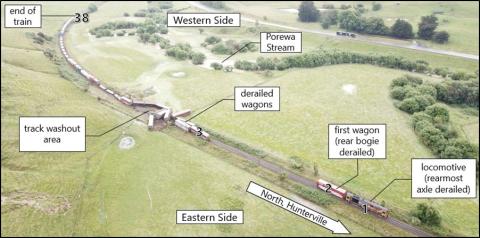The cause of a December 2021 derailment of a freight train near Hunterville was floodwaters washing away the ballast that held the tracks in position, says the Transport Accident Investigation Commission (TAIC).
The Commission today published its final report on the accident that occurred about 11pm on the night of 13 December 2021.
The TAIC report details how a KiwiRail freight train, travelling at night, rounded a curve to be confronted by water flowing across the line from a flooded field. The driver immediately reduced power and then, suspecting the train had derailed, stopped the train.
Seventeen of the train’s 37 wagons and the locomotive had derailed.
The train derailed because it passed over tracks that were bending out of shape because the stone ballast that normally supported them had been washed away by the floodwater.
The Chief Investigator of Accidents, Naveen Kozhuppakalam, says the report shows why people in control of transport infrastructure need to think again about how well their structures can cope with significant rainfall events.
"All the signs are that significant rainfall is increasing in frequency and severity and is increasingly likely to happen in places people don't expect," said Mr Kozhuppakalam.
"This is one more example of a transport infrastructure risk, caused by climate change; the transport industry needs to prepare, be able to adapt and respond to the increase in frequency of unseasonal and severe weather events."
KiwiRail's response to this accident included revised hydrology assessments and flood modelling, new flood-monitoring gauges, and larger capacity culverts. There was no pressing need for the Commission to issue a recommendation in this case.

